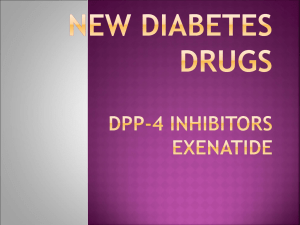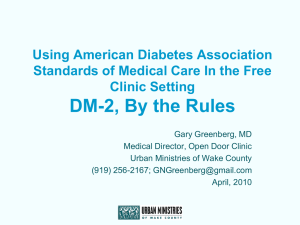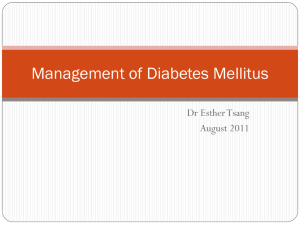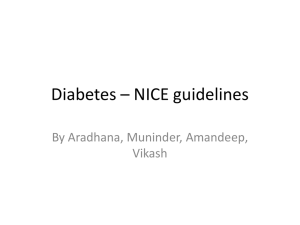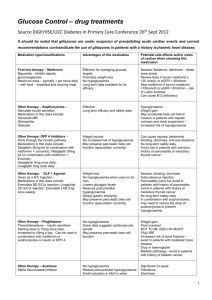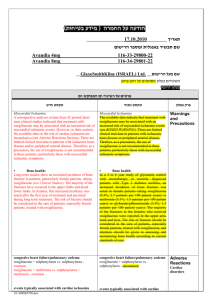Oral hypoglycaemic agents
advertisement
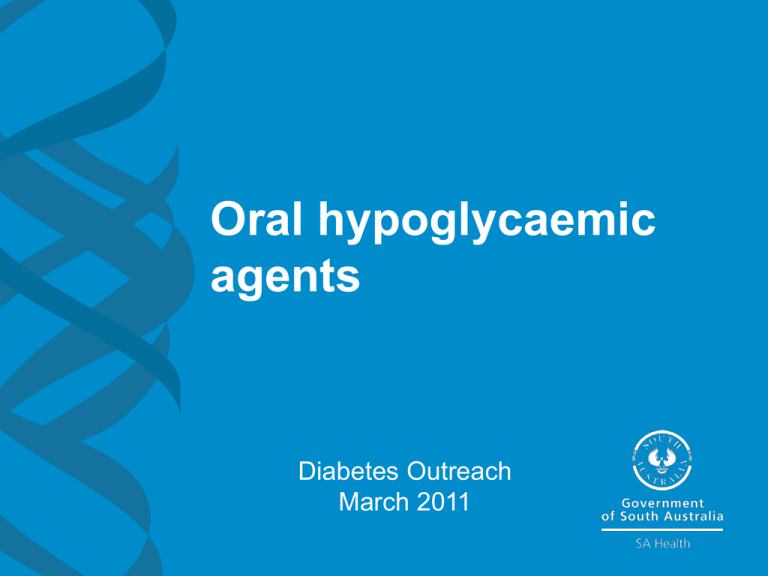
Oral hypoglycaemic agents Diabetes Outreach March 2011 Oral hypoglycaemic agents Learning objectives > Understand the progressive nature of type 2 diabetes and its impact on management. > State the different types of oral hypoglycaemic agents and how they are used. > Describe the main side effects of the medications and implications for practice. 2 Type 2 diabetes > Pathophysiology involves both – insulin resistance – progressive failure of beta-cells to secrete insulin. > Most people with type 2 diabetes ultimately require insulin therapy to achieve glycaemic goals. > Combination therapy often necessary to achieve optimal results (tablets and insulin). 3 Meet Sue…….. > 47 year old current smoker. > Presents to the GP complaining of recurrent vaginal thrush, fatigue and frequent urination. > Previous medical history: – gestational diabetes Sue is newly diagnosed with type 2 diabetes 4 Meet Sue.……. Observations on examination > 74kg and 165cm, BMI 27kg/m2. > Random blood glucose level is 9.2mmol/L. > Blood pressure 148/96mmHg. > Total Cholesterol 6.2mmol/L. – LDL-cholesterol 3.5mmol/L – Triglycerides 1.2mmol/L > Urinalysis is unremarkable. > Results of glucose tolerance test confirm type 2 diabetes and HbA1c is 8.0%. 5 What would you suggest for Sue? 6 Algorithm for type 2 diabetes Lifestyle modification diet modification, weight control, exercise Metformin Sulphonylurea Acarbose DPP-4 Inhibitor # Glitazone * Insulin # Authorised only as dual therapy with metformin or sulphonylurea where combination metformin and sulphonylurea is contraindicated or not tolerated. * Rosiglitazone is not authorised for triple therapy or for use with insulin. This algorithm has been adapted from The NHMRC Blood Glucose Control guidelines. 7 Oral Hypoglycaemics Muscle CHO Thiazolidinediones (Rosiglitazone, Pioglitazone) Glucose Pancreas β Sulphonylureas (Gliclazide, Glimepiride) Liver Glitinides (Repaglinide) Biguanides (metformin) Gut Dipeptidyl peptidase-4 inhibitor (DPP4) Alpha-Glucosidase (Sitagliptin) Inhibitors (Acarbose) Glucagon-like peptide-1 (GLP1) mimetic (Exenatide) 8 Metformin 9 Metformin Mechanism of action: > reduces hepatic glucose production > increases peripheral utilisation of glucose in muscle and fat tissues (increases sensitivity of insulin) > decreases intestinal absorption of glucose > decreases insulin requirements for glucose disposal 10 Metformin > Well tolerated > Side effects: – Common: • GI side effects, malabsorption of vitamin B12 – Infrequent: • Rash – Rare: • Lactic acidosis, acute hepatitis 11 2 years later …… > Sue has a check up with her local GP. > HbA1c was under 7.0mmol/L but now it is 8.3%. > Currently taking Metformin 1.5g BD with meals. What now for Sue? 12 What now for Sue? Lifestyle modification diet modification, weight control, exercise Metformin Sulphonylurea Acarbose DPP-4 Inhibitor # Glitazone * Insulin # Authorised only as dual therapy with metformin or sulphonylurea where combination metformin and sulphonylurea is contraindicated or not tolerated. * Rosiglitazone is not authorised for triple therapy or for use with insulin. This algorithm has been adapted from The NHMRC Blood Glucose Control guidelines. 13 Sulphonylureas 14 Sulphonylureas Action > Increase pancreatic insulin secretion. > May improve insulin sensitivity in peripheral tissue and decrease hepatic glucose output. 15 Sulphonylureas and side effects > Hypoglycaemia is the most frequent and serious adverse effect. > All patients are at risk, but especially: – elderly – renal impairment – hepatic impairment – those receiving interacting drugs. 16 5 years later Sue has been going well with her HbA1c usually under 7%. She has no diabetes complications and her blood pressure and cholesterol are controlled with medication. Over the last 6 months her HbA1c has been steadily rising and is now 7.9%. She is on maximum Metformin and sulphonylurea. What are her options now? 17 What now for Sue? Lifestyle modification diet modification, weight control, exercise Metformin Sulphonylurea Acarbose DPP-4 Inhibitor # Glitazone * Insulin # Authorised only as dual therapy with metformin or sulphonylurea where combination metformin and sulphonylurea is contraindicated or not tolerated. * Rosiglitazone is not authorised for triple therapy or for use with insulin. This algorithm has been adapted from The NHMRC Blood Glucose Control guidelines. 18 Diabetes medications 19 Thiazolidinediones (‘Glitazones’) > Drugs available: – Rosiglitazone (Avandia®). – Pioglitazone (Actos®). > Mechanism of action: – ↑ sensitivity of peripheral tissues to insulin. – ↓ hepatic glucose output. > Slow onset of action compared with other antidiabetic agents. 20 Thiazolidinediones – Side effects > Less propensity for hypoglycaemia than sulphonylureas. – no direct insulin stimulation. > Common: – Peripheral oedema, weight gain, headache, dizziness, arthralgia, decrease in haemoglobin & haematocrit, increase in total and HDL cholesterol (rosiglitazone). > Infrequent: – Distal limb fractures in females. 21 DPP-4 Inhibitor - Sitagliptin > Brand name: Sitagliptin (Januvia®). > Action: – slows breakdown of incretin hormone GLP-1. • increase insulin synthesis and release • decrease glucagon secretion → decreased hepatic glucose production. > Approved for dual therapy. – When HbA1c >7% despite sulphonylurea or metformin. – When sulphonylurea and metformin combination is contraindicated or not tolerated. > Reduce the fasting and post prandial glucose. > Reduce HbA1c by 0.5–0.8% 22 DPP-4 Inhibitor – Sitagliptin Side effects > Common: – Upper respiratory tract symptoms – Headache – Nausea > Rare: – Hypersensitivity reactions eg anaphylaxis, angioedema – Stevens-Johnson syndrome 23 Useful resources National Prescribing Service www.nps.org.au/consumers References > Colagiuri S, Dickinson S, Girgis S, and Colagiuri R (2009) National evidence based guideline for blood glucose control in type 2 diabetes. Diabetes Australia and NHMRC, Canberra. > Diabetes Outreach (2009), Diabetes Manual, Edition 7, Section 10, Medications, Adelaide. > National Prescribing Service (2008) Early use of insulin and oral antidiabetic drugs. National Prescribing Service Newsletter. 25 26
